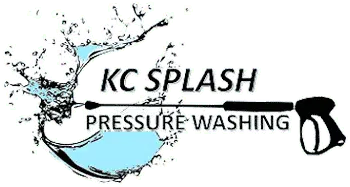Frequently Asked Questions
What is the difference between house washing and pressure washing?
House Washing: House washing involves using a combination of low-pressure water, detergents, and sometimes brushes to clean the exterior surfaces of a house. It’s a gentler approach suitable for delicate materials like siding, stucco, and painted surfaces. House washing is effective for removing dirt, dust, mildew, and other surface contaminants without causing damage. It’s a great option for regular maintenance and improving curb appeal.
Pressure Washing: Pressure washing utilizes a higher-powered stream of water, often with hot water and sometimes with added detergents, to clean tougher surfaces like concrete, brick, and stone. The increased pressure helps remove stubborn stains, grease, mold, and other deep-seated dirt. However, due to the higher pressure, pressure washing is best suited for surfaces that can handle the force without getting damaged. It’s commonly used for driveways, sidewalks, decks, and areas with heavy grime buildup.
In summary, the main difference lies in the water pressure and the surfaces they are best suited for. House washing is a milder approach for more delicate surfaces, while pressure washing is better for heavy-duty cleaning on tougher materials.
Soft Washing Vs Pressure Washing: Which to Do? - Pros & Cons
Soft washing and pressure washing are two distinct methods for cleaning different surfaces. Let’s compare their pros and cons to help you decide which method to use:
Pros:
- Gentle Cleaning: Soft washing uses low-pressure water combined with specialized cleaning solutions. This gentle approach is ideal for delicate surfaces like siding, roofs, and painted areas.
- Effective Stain Removal: The cleaning solutions used in soft washing effectively break down and remove stains, algae, mold, and mildew without causing damage.
- Longer Lasting Results: Soft washing often provides longer-lasting cleanliness as it treats the root cause of the issue by eliminating organisms that cause stains and discoloration.
- Preventative Maintenance: It helps prevent future buildup of contaminants, extending the lifespan of surfaces and reducing the frequency of cleaning.
Cons:
- Limited to Certain Surfaces: Soft washing is not suitable for heavy-duty cleaning tasks on hard surfaces like concrete or stubborn stains.
- Requires Professional Equipment: Proper soft washing requires specific equipment and cleaning solutions that might be best handled by professionals.
Pros:
- Powerful Cleaning: Pressure washing uses high-pressure water to effectively remove tough stains, grease, grime, and dirt from hard surfaces like concrete, brick, and stone.
- Versatility: It’s versatile and can be used for a wide range of outdoor cleaning tasks, including driveways, patios, decks, and fences.
- Immediate Results: Pressure washing provides immediate and noticeable results, making it suitable for quickly restoring surfaces to their original condition.
- DIY Option: Pressure washers are available for rental or purchase, allowing homeowners to tackle certain cleaning tasks on their own.
Cons:
- Risk of Damage: High pressure can cause damage to delicate surfaces, strip paint, and dislodge shingles if not used carefully.
- Lack of Longevity: While pressure washing quickly removes surface dirt, it might not address underlying issues like mold or algae growth as effectively as soft washing.
Conclusion: Choose soft washing when dealing with delicate surfaces that require a gentle approach and for long-lasting results. Opt for pressure washing for tougher surfaces and immediate, visible cleaning results. If unsure, consulting professionals who specialize in these methods can help you make an informed decision based on your specific cleaning needs and surface types.
What is the best thing to wash your house with?
The best thing to wash your house with depends on the type of surface you’re cleaning and the level of dirt or contaminants present. Here are some common options:
Water: For routine maintenance, a simple water rinse using a garden hose can help remove light dust and dirt from surfaces like siding or windows.
Detergent or Soap: Mild detergents or soaps can be effective for general house washing. Mix a solution of water and a gentle detergent, such as dish soap, in a bucket. Apply with a soft brush or sponge and rinse thoroughly.
Specialized House Wash Solutions: There are commercial house wash solutions available that are formulated to clean various exterior surfaces. These solutions often contain specific ingredients to tackle mold, mildew, and other stains.
Bleach Solution: A diluted bleach solution (1 part bleach to 3 parts water) can be used to remove mildew and mold from certain surfaces. However, be cautious when using bleach, as it can damage plants and some materials.
Vinegar Solution: A mixture of white vinegar and water can help dissolve mineral deposits, remove light stains, and inhibit the growth of mold and mildew. It’s a milder option compared to bleach.
Pressure Washer with Detergent: Pressure washers equipped with specialized detergent tanks can be effective for deep cleaning on harder surfaces like concrete, brick, or stone. The pressure washer helps dislodge stubborn grime, while the detergent aids in breaking it down.
Soft Washing Solution: For delicate surfaces like siding, roofs, or painted areas, a soft washing solution, which typically includes a blend of water, detergents, and sometimes mold/mildew inhibitors, can be used. This is applied with low pressure to prevent damage.
Professional Services: When dealing with complex or extensive cleaning needs, hiring professional house washing services can ensure the use of appropriate techniques and products tailored to your specific situation.
Before using any cleaning solution, it’s recommended to test a small, inconspicuous area to ensure it doesn’t cause damage or discoloration. Always follow safety guidelines and manufacturer instructions when using chemicals or pressure washers. If you’re uncertain, consulting a professional for advice is a good idea.
Is power washing a house good or bad?
Power washing, also known as pressure washing, can have both positive and negative effects depending on how it’s used and the surfaces being cleaned. Here’s a breakdown:
Good:
Effective Cleaning: Power washing can effectively remove dirt, grime, mold, mildew, and other buildup from various surfaces, making them look significantly cleaner.
Time and Labor Saving: It can save a lot of time and effort compared to manual scrubbing or cleaning methods.
Preventive Maintenance: Regular power washing can help prevent the buildup of harmful substances that can lead to long-term damage, like rot or deterioration.
Increase Property Value: A clean exterior can improve your property’s curb appeal and potentially increase its value.
Bad:
Damage Risk: Power washing, when used incorrectly or at too high a pressure, can damage surfaces. This is particularly true for softer materials like wood, stucco, and certain types of siding.
Water Intrusion: If water is forced into gaps, cracks, or openings, it can lead to water intrusion, mold growth, or other structural issues.
Environmental Impact: The runoff from power washing can contain detergents and chemicals that can harm plants.
Paint and Surface Removal: Too much pressure can strip paint or coatings, leading to the need for repainting or refinishing.
Conclusion:
Power washing can be very effective and beneficial for cleaning and maintaining surfaces when done correctly. However, it’s important to use the appropriate pressure, nozzles, and techniques for each surface type. If you’re unsure, it’s often wise to hire professionals who are experienced in power washing to ensure the job is done safely and effectively.
How often should a house be power washed?
The frequency of power washing a house depends on various factors, including the climate, the type of siding or exterior material, the level of pollution, and the appearance of dirt and grime. Here are some general guidelines:
Annually or Biannually: In moderate climates with relatively low pollution and minimal buildup, a house might only need power washing once a year or every couple of years. This can help maintain the appearance and prevent long-term damage.
Every 2-3 Years: In areas with more moderate pollution levels or if you have a low-maintenance exterior like brick or stone, you might be able to extend the time between power washings to every 2-3 years.
Every 1-2 Years: For areas with higher pollution, more frequent rain, or if your house has vinyl or wood siding, a power washing every 1-2 years might be more appropriate.
As Needed: If you start noticing mold, mildew, algae, or other buildup on your house, it’s time for a power washing. The appearance of dirt and grime is a good indicator that your house could benefit from a cleaning.
Before Painting or Staining: If you’re planning to repaint or restain your house, power washing is often recommended as a preparation step to ensure the best adherence of the new coating.
Remember, these are just general guidelines. Factors like your personal preference for a clean appearance, the specific conditions in your area, and the type of siding you have can influence how often you should power wash your house. If you’re unsure, consulting with a professional power washing service can help you determine the appropriate schedule based on your circumstances.
What time of the year is best to wash a house?
The best time of year to wash a house typically depends on the climate and specific environmental conditions of your area. However, here are some general guidelines:
Spring: Spring is a popular time for house washing. It’s after the colder winter months, and many people choose to do a thorough cleaning as part of their spring cleaning routine. This can help remove built-up dirt and grime from the winter season.
Early Summer: Early summer, before the hottest temperatures set in, can also be a good time. This ensures your house is clean and looking its best for the summer months when you might be spending more time outdoors.
Fall: Washing your house in the fall can help remove leaves, pollen, and other debris that accumulate during the changing seasons. It’s also a good time to clean before winter sets in.
Before Painting or Staining: If you’re planning to paint or stain your house, washing it beforehand is crucial. This allows for better adhesion of the new paint or stain.
Avoid Extreme Weather: It’s generally best to avoid power washing during extreme weather conditions like very hot, cold, or windy days. Extreme temperatures can affect the effectiveness of the cleaning agents or the drying process.
Consider Local Factors: Depending on where you live, you might need to adjust the timing. For example, areas with high pollen counts might benefit from a cleaning in the early spring. Coastal areas might need more frequent cleanings due to salt and moisture exposure.
Ultimately, the best time to wash your house is when the weather is mild and conducive to drying. If you’re unsure, you might consider consulting with a professional house washing service in your area. They can offer guidance based on local climate conditions and the specific needs of your home’s exterior.
When to Use Pressure and When to Soft Wash
Pressure washing and soft washing serve different purposes and are used depending on the surface and the type of cleaning required. Here’s when to use each method:
Pressure Washing:
Hard Surfaces: Pressure washing is ideal for hard and durable surfaces like concrete driveways, sidewalks, and stone patios. The high pressure can effectively remove tough stains, dirt, and grime from these surfaces.
Tough Stains: For oil stains, grease, graffiti, or other stubborn stains, pressure washing’s higher pressure and forceful water stream can often provide better results.
Brick and Concrete: Pressure washing can help rejuvenate older brick or concrete surfaces, removing years of dirt and weathering.
Quick Cleaning: Pressure washing is generally quicker, making it suitable for larger areas that need a fast and thorough clean.
Delicate Surfaces: Soft washing is ideal for more delicate surfaces like siding, roofing, wood decks, and painted surfaces. These surfaces can be easily damaged by high-pressure water.
Mold and Mildew: Soft washing is particularly effective for removing mold, mildew, algae, and other organic growths without causing damage.
Preventing Damage: Soft washing uses a lower pressure and relies on specialized cleaning solutions, making it safer for preventing damage to surfaces.
Long-Lasting Clean: Soft washing often involves using cleaning solutions that not only clean but also help prevent future growth, keeping surfaces clean for a longer time.
Regular Maintenance: Soft washing is suitable for regular maintenance of surfaces, preventing the need for more intensive cleaning in the future.
Note: Always remember that using too much pressure, even in soft washing, can still cause damage to certain surfaces. It’s important to adjust the pressure and choose the appropriate nozzles or attachments based on the specific cleaning task.
In general, it’s recommended to hire professionals for both pressure washing and soft washing, as they have the expertise to determine the right method, pressure, and cleaning solutions for each surface type and situation.
Why soft wash over pressure wash?
Soft washing is often chosen over pressure washing in situations where the surface is more delicate or prone to damage from high-pressure water. Here are some reasons why you might opt for soft washing:
1. Delicate Surfaces: Soft washing is suitable for surfaces like siding, roofing, wood decks, and painted surfaces, which can be easily damaged by high-pressure water. It provides a thorough clean without the risk of surface harm.
2. Organic Growth: Soft washing is particularly effective for removing organic growth like mold, mildew, algae, and lichen. The specialized cleaning solutions used in soft washing can penetrate and kill these growths, providing a longer-lasting clean compared to pressure washing alone.
3. Preventing Damage: The lower pressure used in soft washing, combined with the cleaning solutions, is less likely to cause damage to surfaces. It’s a safer option for preventing any unintended harm.
4. Lasting Results: Soft washing often involves the use of detergents or biocides that not only clean the surface but also help prevent future growth. This can result in a cleaner surface for a longer period compared to pressure washing.
5. Regular Maintenance: Soft washing is suitable for routine maintenance of surfaces. It can help keep surfaces clean and prevent the need for more frequent, intensive cleaning in the future.
6. Environmentally Friendly: Soft washing typically uses biodegradable and environmentally friendly cleaning solutions. This can be important if you’re concerned about the impact of runoff on plants, animals, and waterways.
7. Energy Efficiency: Soft washing uses less water than pressure washing, making it a more environmentally friendly and potentially cost-effective option.
8. Older Surfaces: Soft washing is a good choice for older surfaces that may have more vulnerabilities due to aging, such as worn-out paint or fragile siding.
Remember, the choice between soft washing and pressure washing depends on the specific surface, the type of dirt or grime you’re dealing with, and your cleaning goals. It’s often best to consult with a professional to determine the most suitable method for your situation.
What PSI should I soft wash my house?
The appropriate PSI (pounds per square inch) for soft washing a house can vary depending on factors like the type of siding, the level of dirt and grime, and the cleaning solution used. Generally, soft washing involves using lower pressure compared to traditional pressure washing.
A typical soft washing PSI range could be around 100 to 500 PSI. This lower pressure helps prevent damage to more delicate surfaces like siding, stucco, wood, and roofing materials. The key with soft washing is to rely more on the cleaning solutions and less on high pressure for effective cleaning.
It’s important to note that the right PSI is only part of the equation. The cleaning solution, the type of nozzle, and the technique used also play crucial roles in achieving a successful soft wash. In many cases, it’s advisable to hire a professional who has experience with soft washing and understands how to balance pressure and cleaning agents for the best results.
If you’re planning to do it yourself, start with the lowest pressure setting and test it in an inconspicuous area to make sure it’s not causing any damage or peeling paint. Always follow manufacturer guidelines for your pressure washer, and if you’re uncertain, consult with experts or professionals who specialize in soft washing.
Is soft washing cheaper than pressure washing?
The cost of soft washing versus pressure washing can vary based on several factors, including the size of the area, the specific cleaning needs, and the location. In some cases, soft washing might be slightly more expensive due to the specialized cleaning solutions used. However, the potential cost savings and benefits of soft washing can make it a cost-effective option in the long run. Here’s why:
Preventive Maintenance: Soft washing often involves using cleaning solutions that not only clean the surface but also help prevent future growth of mold, mildew, and algae. This can result in a longer-lasting clean, reducing the frequency of cleaning required.
Less Frequent Cleaning: Due to the longer-lasting effects of soft washing, you might not need to clean as often, potentially saving you money over time.
Reduced Risk of Damage: The lower pressure used in soft washing reduces the risk of damaging delicate surfaces like siding, wood, and roofing. This can save you from expensive repairs or replacements that might be needed after high-pressure cleaning.
Environmentally Friendly: Soft washing often uses biodegradable and eco-friendly cleaning solutions, which can be beneficial for the environment.
Energy Efficiency: Soft washing uses less water and relies more on the cleaning solution, which can lead to energy and water savings.
Curb Appeal and Property Value: A well-maintained exterior enhances curb appeal and can increase property value. Soft washing’s longer-lasting effects contribute to this.
While the initial cost of soft washing might be slightly higher, considering the potential savings and benefits over time, it can be a cost-effective investment, especially for more delicate or harder-to-clean surfaces. To determine the cost difference between soft washing and pressure washing in your specific situation, it’s recommended to obtain quotes from professional cleaning services that offer both options. They can provide a more accurate assessment based on your needs.
Soft Washing vs. Pressure Washing: When to Use Each Method
Soft Washing and Pressure Washing are two distinct methods used for cleaning various surfaces. Here’s when to use each method:
Soft Washing:
Delicate Surfaces: Use soft washing for delicate surfaces like siding, stucco, wood, and roofing. These materials can be damaged by the high pressure of traditional pressure washing.
Organic Growth: Soft washing is effective for removing organic growth such as mold, mildew, algae, and lichen. The cleaning solutions used in soft washing penetrate and eliminate these growths, providing a longer-lasting clean.
Preventive Maintenance: Opt for soft washing to not only clean but also prevent future growth. The cleaning solutions used can inhibit the return of mold and algae, keeping surfaces cleaner for a longer time.
Regular Maintenance: Use soft washing for routine cleaning of surfaces to reduce the need for more intensive cleaning in the future.
Environmental Concerns: Choose soft washing for environmentally conscious cleaning, as it often uses biodegradable and eco-friendly cleaning solutions.
Pressure Washing:
Hard Surfaces: Use pressure washing for harder surfaces like concrete driveways, sidewalks, and stone patios. The high pressure is effective in removing stubborn stains and dirt from these surfaces.
Tough Stains: Opt for pressure washing for tough stains such as oil, grease, graffiti, and other stubborn marks.
Quick Cleaning: Pressure washing is ideal for larger areas that require fast and thorough cleaning.
Paint Preparation: Choose pressure washing to prepare surfaces for painting or staining. It helps ensure proper adhesion of the new coating.
Industrial and Commercial Cleaning: Pressure washing is often used for heavy-duty cleaning in industrial and commercial settings.
Remember:
- Always consider the material and condition of the surface you’re cleaning.
- Test a small area before full cleaning to avoid potential damage.
- Hire professionals for both methods if you’re unsure or need specialized cleaning.
- The choice between soft washing and pressure washing should be based on the specific surface, the type of dirt, and your cleaning goals.
Is soft washing cheaper than pressure washing?
The cost of soft washing versus pressure washing can vary depending on several factors. While soft washing might have slightly higher initial costs due to the specialized cleaning solutions involved, it can offer cost-saving benefits over time. Here’s a breakdown:
Soft Washing:
Initial Cost: Soft washing can have slightly higher upfront costs due to the specialized cleaning solutions used.
Longevity: Soft washing often includes cleaning solutions that prevent future growth of mold, mildew, and algae. This can lead to a longer-lasting clean, reducing the frequency of cleaning needed.
Reduced Risk of Damage: The lower pressure used in soft washing minimizes the risk of damaging delicate surfaces, potentially saving you from costly repairs.
Less Frequent Cleaning: Due to its longer-lasting effects, you might not need to clean as often, saving you money in the long run.
Environmental and Energy Benefits: Soft washing typically uses less water and more eco-friendly cleaning solutions, which can lead to cost savings and environmental benefits.
Pressure Washing:
Initial Cost: Pressure washing generally has lower initial costs as it doesn’t require specialized cleaning solutions.
Higher Frequency: Because pressure washing might need to be done more frequently due to its shorter-lasting effects, the costs can add up over time.
Potential Damage: Improper pressure washing can cause damage to surfaces, resulting in repair costs.
Preparation for Maintenance: Pressure washing might be necessary as a preparation step before painting or staining, adding to the overall maintenance costs.
In the short term, pressure washing might seem cheaper, but when you consider the longer-lasting effects, reduced need for future cleaning, and potential damage prevention offered by soft washing, it can become a more cost-effective option over time. To determine the most cost-effective method for your specific situation, consider obtaining quotes from professional cleaning services that offer both soft washing and pressure washing. They can provide a more accurate assessment based on your needs and the surfaces to be cleaned.
What chemicals do you use to soft wash a house?
Soft washing involves the use of specialized cleaning solutions that are designed to effectively remove dirt, grime, mold, mildew, and other contaminants from surfaces without the need for high pressure. The specific chemicals used can vary based on the cleaning company, the region, and the type of contaminants present. Here are some common chemicals used in soft washing:
Sodium Hypochlorite: Also known as bleach, sodium hypochlorite is often used as a primary cleaning agent in soft washing solutions. It effectively kills mold, mildew, algae, and bacteria.
Surfactants: These chemicals help break down dirt and grime, allowing the cleaning solution to penetrate and lift contaminants from the surface.
Algaecides and Fungicides: These are used to kill and prevent the growth of algae, mold, and fungi on surfaces.
Water: Soft washing solutions are typically mixed with water to create the right concentration for effective cleaning.
Citric Acid: In some cases, citric acid can be used to remove mineral stains, rust, and oxidation.
Biodegradable Soaps: Eco-friendly soaps can be added to the solution to aid in cleaning and emulsifying contaminants.
Oxygen Bleach: This is a safer alternative to chlorine bleach and can be effective in removing stains and brightening surfaces.
It’s important to note that the use of chemicals in soft washing requires expertise to ensure that the right concentrations are used for effective cleaning without causing damage to surfaces or harm to the environment. Soft washing professionals are trained to select the appropriate chemicals and mixtures based on the specific cleaning needs and the types of surfaces being cleaned. If you’re considering soft washing your house, it’s recommended to hire a reputable and experienced professional who is knowledgeable about the appropriate chemicals and techniques for safe and effective cleaning.
Best Soft Washing Chemicals
As of my last update in September 2021, I can’t provide real-time information on the latest products. However, I can mention some commonly used and reputable soft washing chemicals that were well-regarded up to that point. It’s always a good idea to check for the latest reviews and recommendations in the industry before making a purchase.
Sodium Hypochlorite: Commonly known as bleach, sodium hypochlorite is a powerful disinfectant and cleaner that’s often used in soft washing solutions. It effectively removes mold, mildew, algae, and stains from various surfaces.
Surfactants: Surfactants help break down dirt and grime, allowing the cleaning solution to spread evenly and penetrate contaminants on the surface.
Algaecides and Fungicides: These chemicals are designed to kill and prevent the growth of algae, mold, and fungi on surfaces.
Biodegradable Soaps: Eco-friendly soaps can be added to the solution to aid in cleaning and emulsifying contaminants.
Oxygen Bleach: An alternative to chlorine bleach, oxygen bleach can be effective in removing stains and brightening surfaces without the potential harmful effects of chlorine.
Citric Acid: Citric acid can help remove mineral stains, rust, and oxidation from surfaces.
When looking for soft washing chemicals, consider factors such as effectiveness, safety for the environment and surfaces, compatibility with the surfaces you’re cleaning, dilution requirements, and compliance with local regulations. It’s also a good idea to read reviews and seek recommendations from professionals who have experience in soft washing.
For the most up-to-date recommendations, I recommend checking with reputable suppliers, professional soft washing companies, or industry forums. Always follow the manufacturer’s instructions and safety guidelines when using any chemicals.
Is soft wash better than pressure washing?
Whether soft washing or pressure washing is better depends on the specific situation, the type of surface you’re cleaning, and your cleaning goals. Each method has its own advantages and is suited for different purposes:
Soft Washing:
Delicate Surfaces: Soft washing is better for delicate surfaces like siding, stucco, wood, and roofing. High-pressure water can damage these surfaces, making soft washing a safer option.
Organic Growth: Soft washing is highly effective at removing organic growth like mold, mildew, algae, and lichen due to the use of specialized cleaning solutions.
Preventive Maintenance: Soft washing often includes cleaning solutions that can prevent future growth, leading to a longer-lasting clean.
Environmental Considerations: Soft washing typically uses eco-friendly and biodegradable cleaning solutions, making it a more environmentally conscious choice.
Longevity: The effects of soft washing can last longer due to the cleaning solutions used.
Pressure Washing:
Hard Surfaces: Pressure washing is better for harder surfaces like concrete, stone, and metal that can withstand higher pressure.
Tough Stains: Pressure washing is effective for removing stubborn stains, oil, grease, and grime from surfaces.
Quick Cleaning: Pressure washing is faster for large areas that require thorough cleaning.
Paint Preparation: Pressure washing is often used to prepare surfaces for painting or staining, ensuring better adhesion of new coatings.
In some cases, a combination of both methods might be appropriate. For instance, you could use soft washing for organic growth removal and then pressure wash for tough stains on harder surfaces.
Ultimately, the best choice depends on factors like the type of surface, the type of contaminants, the potential for damage, and your desired outcome. If you’re unsure which method to choose, it’s wise to consult with a professional cleaning service that specializes in both soft washing and pressure washing. They can assess your situation and recommend the most suitable approach.
How long does soft washing last?
The duration of the effects of soft washing can vary depending on several factors, including the type of surface, the level of contaminants, the climate, and the quality of the cleaning job. Here are some general guidelines:
Longevity Factors:
Surface Type: The type of surface being cleaned can influence how long the effects of soft washing last. Different materials, such as siding, roofing, or decks, may require more or less frequent cleaning.
Contaminants: If the area is prone to rapid regrowth of mold, mildew, algae, or other contaminants, you might need more frequent cleaning.
Climate: Areas with high humidity, frequent rain, or damp conditions might experience faster regrowth of organic growth and contaminants.
Cleaning Quality: The thoroughness of the soft washing job and the effectiveness of the cleaning solutions used can impact how long the cleaned surface stays clear of contaminants.
General Guidelines:
Organic Growth: For surfaces with organic growth like mold, mildew, and algae, a good soft washing can typically keep the area clean for at least a year. However, some surfaces might require more frequent cleaning.
Routine Maintenance: For routine cleaning and maintenance, soft washing every 1-3 years might be sufficient to keep surfaces looking their best.
Preventive Maintenance: Soft washing with preventive cleaning solutions can lead to longer-lasting results, as these solutions inhibit the regrowth of contaminants.
Regular Inspections: It’s a good idea to inspect your property periodically and look for signs of regrowth. Addressing the issue early can help maintain a cleaner appearance and potentially extend the time between soft washing sessions.
It’s important to note that while soft washing can provide longer-lasting results compared to pressure washing, the duration of the effects will vary based on the factors mentioned above. Consulting with a professional soft washing service can help you determine the appropriate cleaning schedule based on your specific situation and needs.
Can you softwash with a pressure washer?
Yes, you can perform soft washing with a pressure washer, but it requires specialized equipment and nozzles designed for soft washing. Soft washing involves using low pressure and specialized cleaning solutions to clean delicate surfaces without causing damage. Here’s how you can do it:
Equipment: Use a pressure washer with a low-pressure setting (typically around 100-500 PSI) and a dedicated downstream injector or chemical injector. Some pressure washers come with a soap or chemical attachment specifically for soft washing.
Nozzles: Use a wide-angle nozzle, such as a soap nozzle or a nozzle designed for chemical application. These nozzles allow the cleaning solution to be applied at low pressure.
Cleaning Solution: Use a soft washing solution that is specifically designed for soft washing. This solution typically includes surfactants, algaecides, and other chemicals that effectively remove contaminants while being safe for the surface.
Application: Apply the cleaning solution to the surface using the low-pressure nozzle. Allow the solution to dwell for a specified period, as recommended by the manufacturer.
Agitation: For stubborn stains or heavy buildup, you can lightly agitate the surface with a soft brush or a soft wash broom.
Rinsing: After the dwell time, switch to a regular rinsing nozzle and gently rinse the surface using the low-pressure setting. Be cautious not to use high pressure, as it defeats the purpose of soft washing.
Safety: Wear appropriate safety gear, such as gloves and eye protection, and follow the manufacturer’s instructions for the cleaning solution.
It’s important to note that while you can soft wash with a pressure washer, it’s often best to hire professionals who specialize in soft washing. They have the expertise, equipment, and knowledge of the right cleaning solutions to effectively clean surfaces without causing damage. If you’re not experienced with soft washing, using incorrect techniques or solutions could lead to unintended consequences.
Is soft washing a house worth it?
Soft washing a house can be worth it in many cases, depending on your specific circumstances and goals. Here are some factors to consider when deciding if soft washing is worth it for your home:
Benefits of Soft Washing:
Gentle Cleaning: Soft washing uses low pressure and specialized cleaning solutions, making it a safe and effective way to clean delicate surfaces like siding, stucco, wood, and roofing. It can restore the appearance of your home without causing damage.
Long-Lasting Results: Soft washing often involves using cleaning solutions that not only clean but also prevent future growth of mold, mildew, and algae. This can result in a cleaner surface for a longer period compared to traditional pressure washing.
Curb Appeal: Soft washing can significantly improve the curb appeal of your home by removing unsightly stains, dirt, and organic growth.
Preventive Maintenance: Regular soft washing can help prevent long-term damage to your home’s exterior by removing contaminants that can deteriorate surfaces over time.
Environmental Considerations: Soft washing typically uses biodegradable and eco-friendly cleaning solutions, making it a more environmentally conscious option.
Considerations:
Cost: Soft washing may have a slightly higher initial cost compared to pressure washing, due to the use of specialized cleaning solutions. However, the longer-lasting results and potential cost savings over time can make it a worthwhile investment.
Professional vs. DIY: While you can attempt DIY soft washing, it’s often recommended to hire professionals who are experienced in soft washing. They have the expertise to use the right techniques and solutions to achieve the best results without causing damage.
Frequency: The need for soft washing can vary based on factors like climate, level of contaminants, and surface type. It’s important to consider the frequency of cleaning required in your area.
Surface Condition: If your home’s exterior is heavily stained or covered in mold and mildew, soft washing can be a highly effective way to restore its appearance. However, if the staining is minimal, you might not need soft washing as frequently.
In conclusion, soft washing can be worth it if you want a safe and effective method to clean and maintain your home’s exterior, improve its appearance, and prevent long-term damage. It’s recommended to consult with professionals in the field to assess your specific needs and determine if soft washing is the right choice for your home.
How often should you soft wash your house?
The frequency of soft washing your house can vary depending on factors such as the climate, the level of contaminants, the type of surface, and your personal preferences. Here are some general guidelines to consider:
1. Climate and Environment:
- Areas with high humidity and frequent rain may require more frequent soft washing to combat mold, mildew, and algae growth.
- Coastal areas might need more frequent cleaning due to salt exposure.
2. Surface Type:
- Different surfaces have different cleaning needs. Siding, roofs, decks, and other exterior materials might require varying frequencies of soft washing.
3. Contaminants:
- If your area is prone to high levels of airborne contaminants, like pollen or pollution, you might need more frequent soft washing.
4. Appearance Preferences:
- Some homeowners prefer a cleaner look and might choose to soft wash more often for aesthetic reasons.
5. Preventive Maintenance:
- Soft washing can be used as a preventive measure to inhibit the growth of mold, mildew, and algae. In this case, you might schedule regular soft washing sessions even if the exterior doesn’t appear visibly dirty.
6. Professional Recommendations:
- Consulting with a professional soft washing service can provide valuable insight into how often your specific home should be cleaned based on its condition and local factors.
As a general guideline, soft washing every 1-3 years is common for most homes. However, it’s important to assess your specific situation and needs. Regular inspections of your home’s exterior can help you determine when it’s time for another soft washing session.
Keep in mind that while soft washing has longer-lasting effects compared to pressure washing, the optimal frequency can vary based on the factors mentioned above. Consulting with professionals experienced in soft washing can provide you with a tailored recommendation based on your location, climate, and home’s exterior condition.
How often should a house be power washed?
11 Reasons Why Soft Washing Your Home's Driveway is Better than ...
Soft washing your home’s driveway offers several advantages over traditional pressure washing. Here are 11 reasons why soft washing is often a better choice:
Surface Protection: Soft washing uses low pressure, preventing potential damage to delicate surfaces like concrete and pavers.
Effective Stain Removal: Soft washing’s specialized cleaning solutions penetrate and eliminate stains, oil, grease, and grime more effectively.
Longer-Lasting Clean: Soft washing’s cleaning solutions inhibit regrowth, leading to a cleaner driveway for a longer period.
Environmental Friendliness: Soft washing typically employs eco-friendly, biodegradable solutions that are safer for your yard, plants, and waterways.
No Erosion Risk: Soft washing reduces the risk of erosion caused by high-pressure water, preserving your driveway’s integrity.
No Surface Pitting: Traditional pressure washing can pit or etch surfaces, while soft washing prevents this type of damage.
Gentle on Sealants: Soft washing doesn’t compromise sealants on your driveway, maintaining their protective properties.
Conserves Water: Soft washing uses less water than pressure washing, making it a more environmentally conscious option.
Reduced Noise: Soft washing generates less noise compared to the loud, high-pressure equipment of traditional pressure washing.
No “Zebra” Stripes: Soft washing avoids the uneven cleaning patterns or “zebra” stripes that pressure washing can sometimes leave behind.
Comprehensive Clean: Soft washing not only cleans the surface but also kills the roots of mold, mildew, and algae, preventing future growth.
When it comes to your driveway, soft washing offers a safer, more effective, and longer-lasting solution for maintaining its appearance and integrity. Always consider your specific situation and consult with professionals to determine the best cleaning approach for your driveway.
Is soft washing a roof safe?
Yes, soft washing is generally considered a safe method for cleaning roofs, especially when compared to high-pressure power washing. Soft washing utilizes low pressure and specialized cleaning solutions to remove dirt, algae, mold, and other contaminants from the roof’s surface.
Here’s why soft washing is considered safe for roofs:
Low Pressure: Soft washing uses low pressure, typically less than 500 PSI, which is significantly gentler than the high-pressure water used in power washing. This low pressure reduces the risk of damaging delicate roofing materials.
Specialized Solutions: Soft washing employs specially formulated cleaning solutions that are designed to effectively kill and remove organic growth like algae and mold without harming the roof.
Prevents Damage: Soft washing helps preserve the integrity of the roofing material by avoiding the potential for erosion or granule loss that can occur with high-pressure washing.
Long-Lasting Results: Soft washing solutions often contain additives that inhibit the regrowth of algae and other contaminants, resulting in a cleaner roof for a longer period.
Professional Expertise: Soft washing should ideally be performed by trained professionals who understand the appropriate techniques, solutions, and safety measures for cleaning roofs.
However, it’s important to note a few considerations:
Type of Roofing Material: While soft washing is generally safe for most roofing materials, it’s crucial to consider the type of material. Asphalt shingles, tiles, metal, and other common roofing materials can be safely soft washed.
Professional Service: While some homeowners may attempt DIY soft washing, it’s recommended to hire a professional who is experienced in roof cleaning. They have the necessary equipment and knowledge to ensure a safe and effective clean.
Safety Precautions: Soft washing may involve working at heights, handling chemicals, and using equipment. Safety measures such as proper gear, fall protection, and proper chemical handling are essential.
Always consult with professionals before undertaking any roof cleaning to ensure that the right methods are used and safety is maintained. Soft washing, when done correctly, can effectively clean your roof while minimizing the risk of damage.
How do you soft wash vinyl siding?
Soft washing vinyl siding involves using low pressure and specialized cleaning solutions to safely and effectively remove dirt, mold, mildew, and other contaminants. Here’s a step-by-step guide on how to soft wash vinyl siding:
Materials Needed:
- Soft washing solution (specifically designed for vinyl siding)
- Low-pressure pressure washer
- Soft washing nozzle or soap nozzle
- Safety gear (gloves, goggles, mask)
- Bucket for mixing solution
- Garden hose (for rinsing)
Steps:
Preparation:
- Wear appropriate safety gear, including gloves, goggles, and a mask, to protect yourself from chemicals and splashes.
- Ensure that nearby plants, shrubs, and objects are covered or wet before starting to prevent any potential damage from the cleaning solution.
Mixing the Solution:
- Follow the manufacturer’s instructions to mix the soft washing solution with water in the appropriate ratio. Usually, these solutions are concentrated and need to be diluted.
Pressure Washer Setup:
- Use a low-pressure nozzle (such as a soap nozzle) on your pressure washer. The pressure should be kept below 500 PSI to avoid damaging the vinyl siding.
Applying the Solution:
- Starting from the bottom and working your way up, apply the diluted soft washing solution to the vinyl siding. Make sure to cover the entire surface evenly.
- Allow the solution to dwell on the siding for the recommended amount of time (specified by the manufacturer). This allows the solution to break down contaminants.
Agitation (if needed):
- For stubborn stains or heavily soiled areas, you can lightly agitate the surface using a soft brush or a soft wash broom. Be gentle to avoid scratching the siding.
Rinsing:
- Switch to a clean water nozzle on your pressure washer or use a garden hose to rinse off the siding. Start from the top and work your way down to ensure thorough rinsing.
Final Inspection:
- Check the siding to ensure that all contaminants have been removed. If any areas require further cleaning, you can repeat the soft washing process.
Clean Up:
- Properly dispose of any leftover cleaning solution according to local regulations.
- Rinse nearby plants and landscaping that might have come into contact with the solution.
Remember, soft washing vinyl siding requires a delicate touch and the right equipment. If you’re not comfortable or experienced with this process, it’s recommended to hire a professional soft washing service to ensure the best results without causing damage to your siding.
How long does it take to powerwash a 2000 square foot house?
The time it takes to power wash a 2000 square foot house can vary based on several factors, including the complexity of the job, the level of dirt and grime, the type of surfaces being cleaned, the equipment used, and the expertise of the person performing the power washing. However, as a rough estimate, power washing a 2000 square foot house can take anywhere from 1.5 to 4 hours.
Here are some factors that can influence the time required:
Level of Contamination: If the house has heavy dirt, mold, mildew, or other contaminants, it might take longer to effectively clean the surfaces.
Type of Surfaces: Different surfaces require varying levels of care. For example, if the house has both siding and a deck, the deck might require extra time and attention.
Equipment and Pressure: The type of pressure washer and nozzles used can affect the efficiency of the cleaning process. Higher pressure might clean faster, but it needs to be used carefully to avoid damage.
Obstacles: The presence of obstacles like landscaping, furniture, or obstacles that need to be moved or protected can add to the time.
Skill and Experience: A professional power washer might complete the job faster due to their experience and expertise.
Preparation and Cleanup: Setting up equipment, preparing the area, and cleaning up after the job are additional time factors to consider.
It’s important to note that rushing through power washing can result in uneven cleaning or potential damage to surfaces. For the best results and to ensure that the job is done safely and effectively, it’s recommended to hire a professional power washing service. They can provide a more accurate estimate based on the specific conditions of your house.
Is it OK to pressure wash vinyl siding?
Pressure washing vinyl siding is generally safe if done correctly and with proper care. However, there are some important considerations to keep in mind to ensure that you don’t damage the siding:
Low Pressure:
- Use a pressure washer with adjustable pressure settings and start with the lowest setting.
- Maintain a pressure of around 1,000 to 1,500 PSI (pounds per square inch) to prevent damage to the siding.
Wide Spray Pattern:
- Use a wide-angle nozzle (usually 25-40 degrees) to disperse the water over a larger area. This reduces the concentration of pressure on a specific spot.
Keep a Safe Distance:
- Stand several feet away from the siding while using the pressure washer to prevent causing dents, chipping, or water penetration.
Angle of Spray:
- Hold the pressure washer nozzle at a slight downward angle. Avoid spraying water directly upwards, which can force water behind the siding.
Avoid High Pressure and Sharp Angles:
- High pressure or shooting water at sharp angles against the siding can potentially force water behind the siding, leading to damage and mold growth.
Test in an Inconspicuous Area:
- Before starting, test the pressure washer in an inconspicuous area to ensure that the pressure is not causing damage or removing paint.
Cleaning Solutions:
- You can use a mild cleaning solution specifically designed for vinyl siding to aid in the cleaning process. Follow manufacturer recommendations for dilution and application.
Inspect for Damage:
- After pressure washing, inspect the siding for any signs of damage or water penetration. Address any issues promptly.
While pressure washing can be effective for cleaning vinyl siding, it’s important to exercise caution and avoid using excessive pressure. If you’re not comfortable or experienced with pressure washing, consider hiring a professional to ensure that the job is done safely and without causing damage to your siding.
Does soft wash damage shingles?
When performed correctly by trained professionals, soft washing should not damage shingles. In fact, soft washing is often considered a safer alternative to high-pressure power washing for cleaning shingle roofs. Here’s why:
Low Pressure: Soft washing involves using low pressure, typically below 500 PSI, to apply specialized cleaning solutions to the surface. This low pressure is much gentler on shingles compared to the high pressure of power washing.
Specialized Solutions: Soft washing solutions are specifically formulated to target and remove organic growth like algae, mold, and mildew. These solutions are designed to break down contaminants without causing damage to the shingles.
Preventive Maintenance: Soft washing solutions often contain additives that inhibit the regrowth of algae and other contaminants. This preventive aspect helps maintain the cleanliness of the roof for a longer period.
Less Risk of Granule Loss: High-pressure power washing can dislodge granules from shingles, potentially reducing their effectiveness and lifespan. Soft washing minimizes this risk.
Proper Technique: Soft washing should be performed by professionals who understand the appropriate techniques and safety measures. This includes using the correct dilution ratios for cleaning solutions and applying them evenly.
However, it’s important to note a few considerations:
Professional Service: While some homeowners may attempt DIY soft washing, it’s recommended to hire a professional who is experienced in roof cleaning. They have the necessary equipment and knowledge to ensure a safe and effective clean.
Roof Condition: If your roof is old, damaged, or in poor condition, soft washing might not be recommended. In such cases, consulting with roofing experts is advisable before any cleaning process.
Quality of Service: The outcome largely depends on the quality of the service provider. A reputable and experienced soft washing professional is crucial to ensure that the process is safe and effective.
Always consult with professionals before undertaking any roof cleaning to ensure that the right methods are used and safety is maintained. When done correctly, soft washing is a safer and more effective way to clean shingle roofs compared to high-pressure power washing.
What do professionals use to clean vinyl siding?
Professionals typically use a combination of specialized equipment and cleaning solutions to effectively clean vinyl siding. Here’s what professionals often use for cleaning vinyl siding:
Soft Washing Solution: Professionals use specially formulated soft washing solutions that are designed to break down and remove dirt, grime, mold, mildew, and other contaminants from vinyl siding. These solutions are typically biodegradable and eco-friendly.
Pressure Washer: A pressure washer is used with a low-pressure setting (typically around 1000-1500 PSI) and a wide-angle nozzle (25-40 degrees) to evenly disperse the cleaning solution and rinse the siding.
Chemical Injector or Downstream Injector: This is a component that allows the soft washing solution to be mixed with water as it’s sprayed from the pressure washer. It ensures a consistent application of the cleaning solution.
Brushes and Soft Brooms: Professionals might use soft brushes or brooms to gently agitate areas with stubborn stains or heavily soiled spots.
Safety Equipment: Professionals wear safety gear such as gloves, goggles, and masks to protect themselves from chemicals and splashes.
Steps Followed by Professionals:
Preparation: Professionals will prepare the area by wetting nearby plants, shrubs, and objects to protect them from the cleaning solution.
Mixing Solution: They’ll mix the soft washing solution with water in the appropriate ratio, as recommended by the manufacturer.
Pressure Washing: Using the pressure washer with the low-pressure setting and a wide-angle nozzle, they’ll apply the cleaning solution to the vinyl siding, starting from the bottom and working their way up.
Dwell Time: They’ll allow the solution to dwell on the siding for a specified time to break down contaminants effectively.
Agitation: For stubborn stains, they might gently agitate the surface with a soft brush or broom.
Rinsing: After the dwell time, they’ll rinse off the siding using the pressure washer, starting from the top and working down.
Final Inspection: Professionals will inspect the siding to ensure that all contaminants have been removed.
Clean Up: They’ll clean up the area, properly disposing of any leftover cleaning solution according to regulations.
Using specialized equipment and techniques, professionals are able to clean vinyl siding thoroughly and safely without causing damage. If you’re not experienced with this process, it’s recommended to hire a professional to ensure the best results.
What time of day is best to pressure wash?
The best time of day to pressure wash depends on various factors, including weather conditions, the specific surface you’re cleaning, and your personal schedule. Here are some considerations for choosing the optimal time to pressure wash:
Morning or Late Afternoon: Many professionals recommend pressure washing in the early morning or late afternoon. During these times, the sun is not at its peak, which can help prevent the cleaning solution from drying too quickly on the surface. It also reduces the risk of heat-related issues for you as you work.
Avoid Midday Heat: Avoid pressure washing during the hottest part of the day, typically from late morning to early afternoon. High temperatures and direct sunlight can cause the cleaning solution to evaporate quickly and make the cleaning process less effective.
Weather Conditions: Choose a day with mild weather conditions, avoiding windy days as wind can blow debris and cleaning solution onto nearby surfaces or into your face.
Safety and Comfort: Consider your own comfort and safety. Pressure washing can be physically demanding, so choose a time when you can work comfortably without the risk of overheating.
Local Regulations: Check if there are any local regulations or noise ordinances that restrict the hours during which you can operate a pressure washer.
Surface Sensitivity: If you’re pressure washing delicate surfaces like wood or painted surfaces, the time of day might matter more. Pressure washing during cooler hours helps prevent the cleaning solution from damaging these surfaces.
Sun Angle: Depending on the direction your surfaces face, the sun’s angle might affect drying times. For surfaces facing the sun, pressure wash when the area is shaded.
Remember, proper pressure washing involves more than just the time of day. Be sure to follow manufacturer instructions for cleaning solutions, use appropriate pressure levels, and take necessary safety precautions. If you’re unsure about any aspect of pressure washing, consider hiring a professional who can ensure the job is done safely and effectively.
How do you pressure wash a house with vinyl siding?
Pressure washing a house with vinyl siding requires careful technique and proper equipment to ensure effective cleaning without damaging the siding. Here’s a step-by-step guide to pressure washing vinyl siding:
Materials Needed:
- Pressure washer with adjustable pressure (around 1500 PSI or less)
- Wide-angle nozzle (25-40 degrees)
- Cleaning solution (specifically formulated for pressure washing and safe for vinyl siding)
- Safety gear (gloves, goggles, mask)
- Garden hose (for water supply)
- Soft brush or broom (for agitating stubborn spots, if needed)
Steps:
Preparation:
- Wear appropriate safety gear, including gloves, goggles, and a mask, to protect yourself from debris and cleaning solution.
- Remove or cover any items near the house that could be affected by the cleaning solution.
Mix Cleaning Solution:
- Follow the manufacturer’s instructions to mix the cleaning solution with water in the appropriate ratio. Be sure to choose a solution that is safe for vinyl siding.
Pressure Washer Setup:
- Attach the wide-angle nozzle to the pressure washer wand.
- Connect the pressure washer to a water supply and ensure it’s in good working condition.
Test in an Inconspicuous Area:
- Before starting, test the pressure washer in an inconspicuous area to make sure it’s not causing any damage to the vinyl siding.
Applying the Solution:
- Starting from the bottom and working your way up, apply the diluted cleaning solution to the vinyl siding. Ensure even coverage.
Dwell Time:
- Allow the cleaning solution to dwell on the siding for a few minutes (follow manufacturer recommendations). This gives the solution time to break down dirt and grime.
Pressure Washing:
- Begin pressure washing from the top and work your way down. Hold the pressure washer wand at a slight downward angle to prevent water from getting behind the siding.
- Maintain a safe distance from the siding (about 1-2 feet) to prevent damage.
Rinsing:
- Switch to the regular water nozzle on your pressure washer or use a garden hose to rinse off the siding. Start from the top and work your way down.
Agitation (if needed):
- For stubborn spots or heavily soiled areas, gently scrub with a soft brush or broom.
Final Inspection:
- Inspect the siding to ensure that all dirt and cleaning solution residues have been removed.
Clean Up:
- Properly dispose of any leftover cleaning solution according to local regulations.
- Rinse nearby plants and landscaping that might have come into contact with the solution.
Remember, improper pressure washing can damage vinyl siding. If you’re unsure or not comfortable with the process, consider hiring a professional pressure washing service to ensure the job is done safely and effectively.
Does bleach hurt vinyl siding?
Bleach can potentially harm vinyl siding if it’s not used correctly. While bleach can effectively remove mold, mildew, and algae, it can also cause discoloration, fading, and damage to the siding if not properly diluted and applied. Here are some important points to consider:
Dilution: Bleach should be diluted with water before applying it to vinyl siding. Using a high concentration of bleach can lead to damage and discoloration.
Testing: Before using bleach on your entire siding, test it in a small, inconspicuous area to ensure that it doesn’t cause any adverse reactions or damage.
Application: If you decide to use bleach, apply it sparingly and carefully. Avoid letting the bleach solution sit on the siding for too long, as prolonged exposure can lead to damage.
Protection: Protect nearby plants, landscaping, and surfaces from direct contact with bleach, as it can harm vegetation and other materials.
Alternatives: There are specialized cleaning solutions available that are designed for use on vinyl siding. These products are formulated to effectively clean without causing damage or discoloration.
Professional Help: If you’re unsure about using bleach or cleaning your vinyl siding, it’s recommended to hire a professional who has experience with cleaning vinyl siding safely and effectively.
Overall, while bleach can be effective for cleaning, it’s important to exercise caution when using it on vinyl siding. If not used correctly, bleach can potentially cause more harm than good. Using a vinyl-safe cleaner or hiring a professional cleaner is often a safer and more reliable option for maintaining the appearance of your vinyl siding.
What is the best thing to wash your house with?
The best thing to wash your house with depends on the type of surface you’re cleaning and your specific cleaning needs. Different surfaces and contaminants may require different cleaning solutions. Here are some options for washing your house based on common scenarios:
Vinyl Siding:
- Use a specialized vinyl siding cleaner that is formulated to effectively remove dirt, mold, and mildew without causing damage.
Brick or Concrete:
- A mixture of water and mild dish soap can be effective for cleaning brick or concrete surfaces. For more stubborn stains, a commercial concrete cleaner may be used.
Wood Siding or Decks:
- A mixture of water and mild dish soap is gentle enough for wood surfaces. You can also consider using a wood cleaner specifically designed for decks.
Mold and Mildew Removal:
- For mold and mildew, a mixture of water and white vinegar or hydrogen peroxide can be effective. There are also commercial mold and mildew cleaners available.
General Cleaning:
- For general cleaning, a mixture of water and a mild household cleaner can work well on a variety of surfaces. Always test a small, inconspicuous area first to ensure compatibility.
Specialized Cleaners:
- There are a variety of commercial cleaners designed for specific purposes, such as removing rust stains, oil stains, or hard water deposits.
Remember these important tips when washing your house:
- Always follow the manufacturer’s instructions on cleaning solutions.
- Test any cleaning solution in a small, inconspicuous area before applying it to larger surfaces.
- Use the appropriate equipment, such as a pressure washer or soft brush, depending on the surface.
- Take necessary safety precautions, including wearing gloves, goggles, and appropriate clothing.
- If you’re uncertain about the best cleaning method for your specific situation, consider consulting with professionals who specialize in house washing and exterior cleaning.
What are the cons of pressure washing?
While pressure washing is an effective method for cleaning various surfaces, it does come with some potential drawbacks and limitations. Here are some of the cons of pressure washing:
Surface Damage: High-pressure water can cause damage to certain surfaces, especially delicate materials like wood, vinyl, and soft stone. Improper technique or excessive pressure can lead to etching, gouging, or even stripping away paint, sealant, or protective coatings.
Water Penetration: Pressure washing can force water into gaps, cracks, or seams, potentially leading to water infiltration into your home’s structure, causing moisture issues, and promoting mold growth.
Risk of Injury: The powerful spray of a pressure washer can cause injuries if not used properly. The water jet can cut skin, cause bruises, and even penetrate through clothing. Eye injuries are also a concern.
Environmental Impact: Pressure washing uses a significant amount of water, which can contribute to water waste, especially if not managed properly. The cleaning solutions and debris from pressure washing can also end up in local waterways, potentially harming the environment.
Stripping Paint or Finishes: High-pressure water can strip away paint, stain, or other finishes from surfaces, leading to the need for repainting or refinishing.
Lack of Precision: Pressure washing is a broad and powerful cleaning method. It might not be suitable for intricate or delicate areas that require a more controlled approach.
Health Hazards: Pressure washing can stir up dust, debris, and contaminants, potentially causing respiratory issues or exacerbating allergies.
Noise and Disruption: Pressure washing can be loud and disruptive to you, your neighbors, and your household, especially if done during inconvenient hours.
Cost of Equipment: If you’re considering doing it yourself, there’s an initial cost to purchasing or renting a pressure washer and its accessories.
Improper Cleaning: Using the wrong pressure or technique can result in surfaces not being cleaned effectively. For some delicate surfaces, pressure washing might not be the best cleaning method.
Risk of Lead Exposure: If your home was painted before 1978, it might have lead-based paint. Pressure washing can potentially release lead particles into the air or the ground if proper precautions aren’t taken.
To mitigate these cons, it’s essential to use the correct pressure, techniques, and equipment, or to consider hiring a professional if you’re not experienced with pressure washing. Assess the specific needs of the surfaces you’re cleaning and carefully weigh the pros and cons before deciding to pressure wash.
What are the disadvantages of a pressure washer?
Pressure washers are powerful tools for cleaning a variety of surfaces, but they also come with certain disadvantages and limitations. Here are some of the disadvantages of using a pressure washer:
Surface Damage: One of the most significant disadvantages of pressure washing is the potential for causing damage to surfaces. High-pressure water can strip paint, gouge wood, etch soft stone, and even crack certain materials if not used properly.
Water Consumption: Pressure washers use a significant amount of water, which can lead to water wastage. This is a concern in areas with water scarcity or when water bills are a consideration.
Environmental Impact: The runoff from pressure washing, especially if cleaning solutions are used, can end up in local waterways, potentially harming aquatic life and the environment.
Risk of Injury: The high-pressure stream of water can cause injuries if it comes into contact with the skin, eyes, or body. It can also dislodge debris that might hit the user or bystanders.
Lack of Precision: Pressure washers provide a broad, powerful spray, making it less suitable for precise or delicate cleaning tasks.
Cost of Equipment: Pressure washers can be expensive to purchase, and even renting them can add to the cost. Maintenance and repairs are additional considerations.
Noise and Disruption: Pressure washers can be noisy and disruptive, potentially causing disturbances for you, your neighbors, and your household.
Surface Precautions: Delicate surfaces, such as old or weathered wood, vinyl siding, or certain types of stone, require special care and lower pressure to avoid damage.
Health Hazards: Pressure washing can stir up dust, mold spores, and other allergens, potentially causing respiratory problems or exacerbating existing conditions.
Time and Effort: While pressure washing can be efficient, it can still be time-consuming, especially for larger areas or heavily soiled surfaces. Setting up, cleaning up, and maneuvering the equipment all take time and effort.
Not Suitable for All Surfaces: Certain surfaces, such as older or deteriorating masonry, might not be suitable for pressure washing due to the risk of damage.
Learning Curve: Using a pressure washer effectively requires some knowledge and skill. Improper technique can lead to subpar cleaning results or even cause damage.
Despite these disadvantages, pressure washers can be highly effective tools when used correctly and on appropriate surfaces. It’s important to assess the specific needs of the cleaning task, prioritize safety, and consider whether a pressure washer is the best choice or if an alternative cleaning method might be more suitable.
How do you soft wash concrete?
Soft washing concrete involves using a specialized cleaning solution and low-pressure equipment to remove dirt, stains, mold, mildew, and other contaminants from the surface. Here’s a step-by-step guide on how to soft wash concrete:
Materials Needed:
- Soft washing solution (concrete-safe cleaner)
- Low-pressure pressure washer
- Soft washing nozzle or soap nozzle
- Safety gear (gloves, goggles, mask)
- Broom or brush (optional)
- Garden hose (for rinsing)
Steps:
Preparation:
- Wear appropriate safety gear, including gloves, goggles, and a mask, to protect yourself from chemicals and splashes.
- Wet nearby plants, shrubs, and objects to protect them from the cleaning solution.
Mixing the Solution:
- Follow the manufacturer’s instructions to mix the soft washing solution with water in the appropriate ratio. Make sure the cleaner is safe for concrete surfaces.
Pressure Washer Setup:
- Use a low-pressure nozzle (such as a soap nozzle) on your pressure washer. The pressure should be kept low, typically below 1500 PSI.
Applying the Solution:
- Starting from one end of the concrete surface, apply the diluted soft washing solution using the pressure washer. Ensure even coverage.
Dwell Time:
- Allow the solution to dwell on the concrete for the recommended amount of time (usually a few minutes to break down contaminants).
Agitation (if needed):
- For stubborn stains, you can gently scrub the surface using a soft brush or broom. Avoid using abrasive tools that could damage the concrete.
Rinsing:
- Switch to a clean water nozzle on your pressure washer or use a garden hose to rinse off the concrete. Start from the top and work your way down.
Final Inspection:
- Check the concrete surface to ensure that all contaminants have been removed. If needed, you can repeat the process for stubborn spots.
Clean Up:
- Properly dispose of any leftover cleaning solution according to local regulations.
- Rinse nearby plants and landscaping that might have come into contact with the solution.
Note: Soft washing concrete is a delicate process. Always test a small, inconspicuous area before proceeding to the entire surface to ensure that the cleaning solution doesn’t cause any adverse reactions. If you’re not comfortable with the soft washing process, consider hiring a professional who has experience with cleaning concrete safely and effectively.
Your In Good Hands!
We want you to know
We are committed to your happiness















